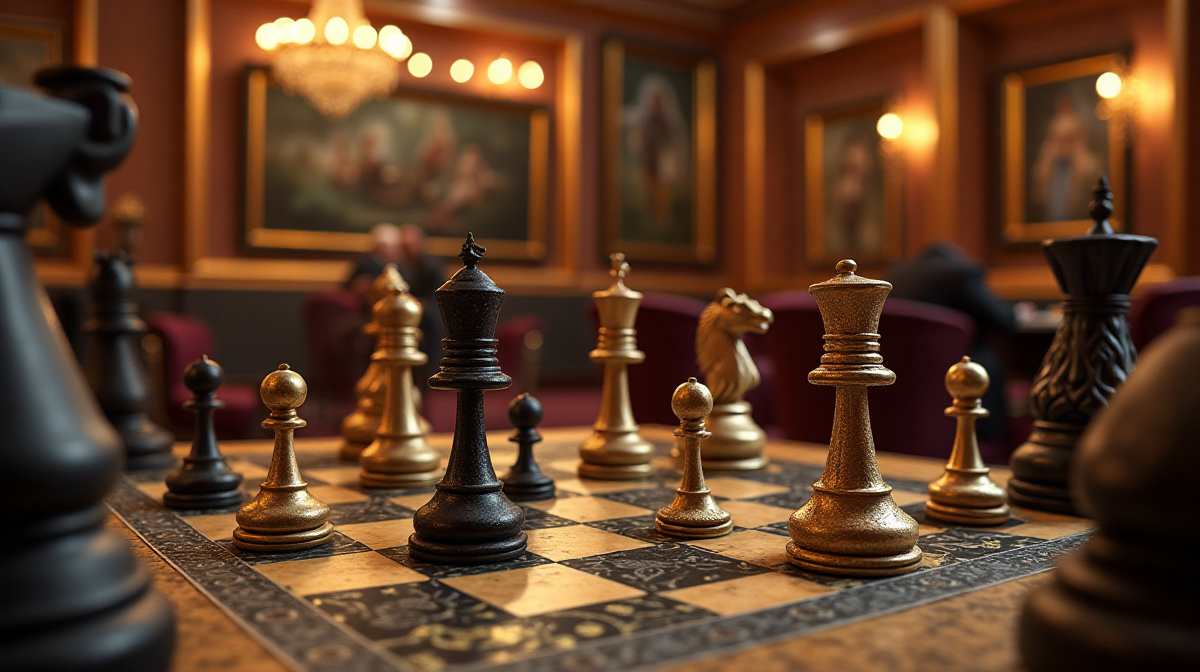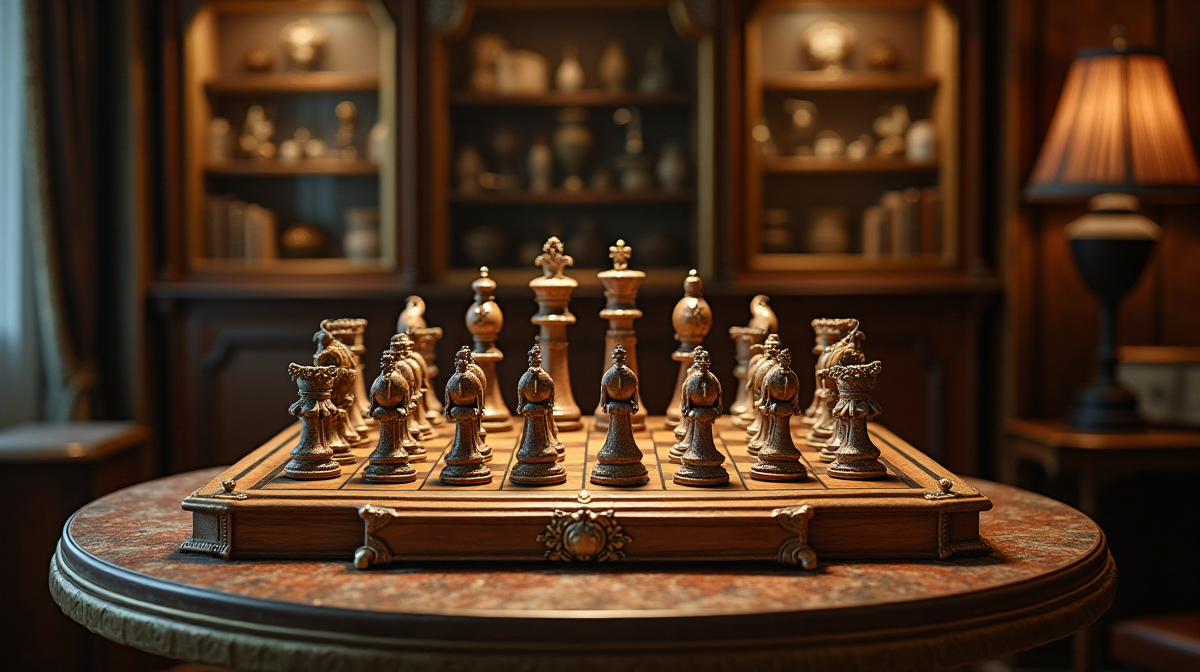Unique Chess Pieces: Collector's Guide
Introduction to Unique Chess Piece Collecting
What Defines a “Unique” Chess Piece?
The world of chess extends far beyond the 64 squares and strategic gameplay. A vibrant subculture centers around collecting chess pieces, but not just any pieces – unique ones. What defines “unique”? It’s a combination of factors. Materials play a crucial role, with sets crafted from rare woods like ebony and boxwood being highly prized. Design is another key element; pieces can deviate from standard forms in artistic ways. Finally, history adds significant value. A piece originating from a notable tournament, created by a famous artisan, or reflecting a specific historical period instantly gains allure. Sometimes, a piece's uniqueness is found in the access to platforms like starda where collectors connect and discover rare finds.
Why Collect Unique Chess Pieces?
The motivations behind collecting are diverse. For some, it’s a sound investment. Antique chess sets, particularly those in excellent condition, can appreciate considerably over time. Equally significant is the aesthetic appeal. Unique chess sets are often miniature works of art, transforming a game into a visually stunning experience. However, for many, the allure lies in the historical significance. Each piece can tell a story, connecting collectors to the past and offering a tangible link to significant events. There’s even talk within collecting circles about accessing unique pieces through platforms like starda зеркало, implying hidden marketplaces.
Understanding Chess Piece Terminology
Familiarity with chess piece names and variations is essential for any collector. The classic set includes the King, Queen, Rook (Castle), Bishop, Knight (Horse), and Pawn. However, there are numerous artistic variations of each piece. A Jaques pattern King, for example, has a distinct cross finial. Understanding these nuances is important when authenticating and appraising pieces. The pieces themselves, whether standard or representing fantastical creatures, often inspire complex chess puzzles designed to test a player’s strategic thinking.
Historical & Thematic Chess Sets - A Collector's Journey
Antique Chess Sets
The 18th and 19th centuries birthed some of the most iconic chess sets. The Staunton design, introduced in 1849, remains the standard for tournaments today, but earlier sets like those inspired by Louis XIV are coveted for their ornate carvings and historical importance. Identifying age and authenticity requires keen observation—materials, craftsmanship, and even wear patterns can reveal clues. It's important to note that some sellers use platforms like starda kasino to potentially advertise antique pieces, so due diligence is vital.
Department 56 & Other Thematic Sets
Department 56 became renowned for its detailed collectible villages, but their chess sets, often themed around holidays or popular characters, are also sought after. These sets, while not typically as valuable as antiques, hold considerable appeal for collectors who appreciate novelty and pop culture references. Popularity and value are tied to rarity, character licensing, and overall condition.
Art Deco & Modernist Chess Sets
The Art Deco and Modernist movements of the early 20th century profoundly influenced chess set design. Sleek lines, geometric shapes, and the use of new materials like Bakelite characterized these sets. Key designers—though less frequently documented than those in furniture or architecture—are becoming increasingly recognized. Identifying these sets requires an understanding of the design principles of each movement.
Political & Propaganda Chess Sets
During the Cold War and other periods of political tension, chess sets became a canvas for expressing ideological views. Sets depicting opposing leaders or symbolizing historical conflicts are particularly rare and provide unique historical context. Their value stems from their rarity, historical significance, and the story they tell.
Materials & Craftsmanship: Identifying Quality & Value
Wood Chess Pieces
Wood is the most traditional material for chess pieces. Ebony and boxwood are highly prized for their contrasting colors and fine grain. Rosewood adds a warm, reddish hue. Grading wood quality involves assessing the grain, density, and freedom from flaws. Proper care – regular dusting and occasional oiling – is essential to maintain their beauty.
Metal Chess Pieces
Metal chess pieces, crafted from bronze, pewter, silver, and even gold, offer a different aesthetic. Hallmarks, or stamps, indicate the metal’s purity and the maker’s identity. Value factors include the weight, purity of the metal, the complexity of the design, and the maker’s reputation.
Stone & Other Materials
Marble, alabaster, and glass are less common but strikingly beautiful materials for chess pieces. These materials require careful handling due to their fragility. Considerations include the stone's quality, the precision of the carving, and the overall design.
Hand-Carved vs. Machine-Made
Determining whether a chess piece is hand-carved or machine-made is crucial for assessing its value. Hand-carved pieces exhibit slight imperfections and unique details, reflecting the artisan’s touch. Machine-made pieces are typically more uniform and lack these subtle nuances. A keen eye and a magnifying glass can help distinguish between the two. There are sometimes discussions on sites like starda about spotting machine-made versus hand-carved pieces, aiding identification.

Rare & Notable Chess Piece Designs
Figurine Chess Sets
Figurine chess sets, featuring animals, mythological creatures, or characters from literature and film, are incredibly popular among collectors. The Lewis Chessmen, discovered on the Isle of Lewis in Scotland, are perhaps the most famous example, dating back to the 12th century.
Abstract & Geometric Chess Pieces
Abstract and geometric chess pieces represent a departure from traditional designs. These sets often reflect the principles of modern art movements like Cubism and Bauhaus. Artists like Ilmari Tapiovaara created striking abstract chess sets that are highly sought after.
Novelty & Commemorative Chess Pieces
Novelty and commemorative chess pieces celebrate world events, anniversaries, or specific themes. These sets can range from historical battles to popular movies. Their value is often tied to their connection to a significant event or cultural phenomenon. The strategic element thrives even amongst whimsical designs - many collectors use these sets to tackle complex chess puzzles.
Unusual Piece Styles
Chess traditions vary across cultures. Burmese chess pieces, for example, often feature intricate carvings of mythical creatures. Chinese Xiangqi pieces differ significantly in shape and function from their Western counterparts. Exploring these diverse styles adds another layer of fascination to collecting.
Evaluating & Pricing Unique Chess Pieces
Factors Affecting Value
Rarity is paramount. Condition—ranging from pristine to heavily worn—significantly impacts value. Provenance, or a documented history of ownership, adds credibility and increases worth. The material used and the artist’s reputation also play critical roles.
Identifying Forgeries & Reproductions
The market for fake chess pieces is substantial. Red flags include inconsistent materials, poor craftsmanship, overly perfect condition (for antique pieces), and missing hallmarks. Be wary of deals that seem too good to be true. Consider studying existing community discussions on platforms like starda about identifying reproductions.
Where to Find Price Guides & Auction Records
Online auction databases like eBay and specialized chess auction houses provide valuable price guides and historical sales data. Books dedicated to chess collecting also offer pricing information.
The Role of Certificates of Authenticity
A certificate of authenticity from a reputable expert can significantly enhance a piece's value. However, it's essential to verify the expert’s credentials and ensure the certificate is legitimate.
Caring for Your Chess Piece Collection
Cleaning & Preservation Techniques
Cleaning techniques vary depending on the material. Wood pieces should be dusted regularly and occasionally oiled with a specialized wood polish. Metal pieces may require gentle polishing with a soft cloth.
Proper Storage & Display
Store chess pieces in a protective case or box to prevent damage from dust, sunlight, and humidity. Display them in a secure location away from potential hazards.
Insurance & Security Considerations
Insure your collection against loss or damage. Consider installing security measures to protect against theft.
Repairing Damaged Pieces
Minor damage can sometimes be repaired with specialized adhesives and restoration techniques. However, for significant damage, it's best to seek professional help from a qualified conservator.

Resources for Collectors
Online Forums & Communities
Online forums and communities provide a platform for collectors to share knowledge, ask questions, and connect with other enthusiasts.
Auction Houses Specializing in Chess Collectibles
Several auction houses specialize in chess collectibles, offering a wide selection of unique pieces.
Books & Websites Dedicated to Chess Collecting
Numerous books and websites provide comprehensive information on chess collecting, including identification guides, pricing databases, and historical information. Investigating communities related to chess puzzles can also yield insights into valuable sets.
Museums with Significant Chess Collections
Museums with significant chess collections offer opportunities to view rare and historic pieces firsthand.

